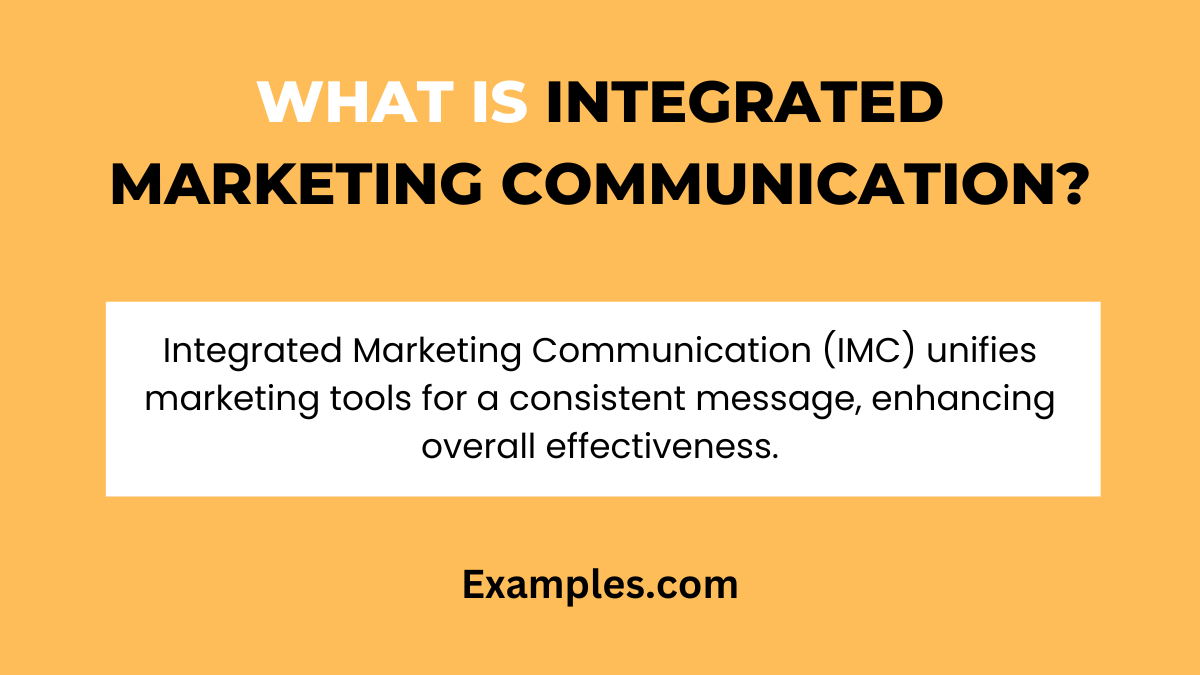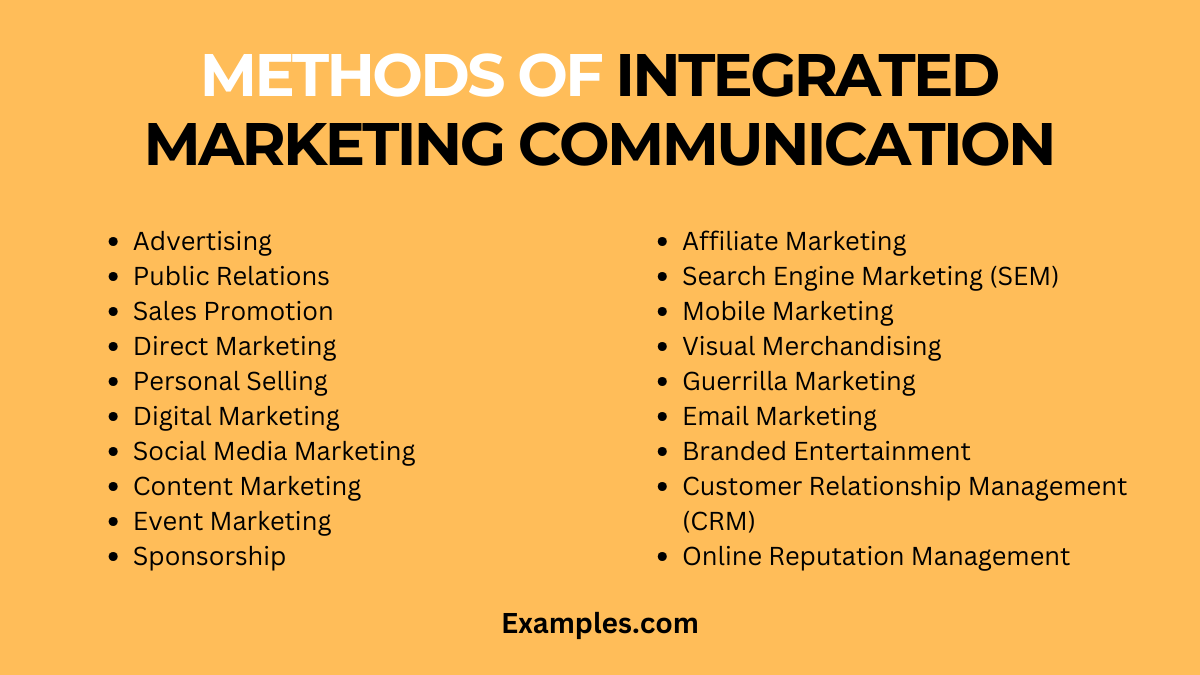40+ Integrated Marketing Communication Methods Examples
Integrated Marketing Communication (IMC) is a strategic approach combining various marketing communication tools and channels to deliver a consistent message about a brand. This complete guide, enriched with marketing communication examples, offers insights into how businesses can leverage IMC for a cohesive and impactful marketing strategy. By integrating tools like advertising, public relations, social media, and direct marketing, IMC ensures that all forms of communication work together harmoniously, enhancing the overall effectiveness of marketing campaigns. From crafting a unified brand message to selecting the right mix of channels, this guide provides the necessary knowledge and examples to help you successfully implement IMC in your marketing endeavors.
What is Integrated Marketing Communication?

Integrated Marketing Communication (IMC) is a strategic approach that combines various forms of marketing, advertising, and communication tools and strategies to create a cohesive and unified message across all channels. This approach ensures that all messaging and communication strategies are consistent and work together to effectively reach and engage the target audience, thus enhancing the overall impact and effectiveness of the marketing effort.
What Are The Methods of Integrated Marketing Communication

Integrated Marketing Communication (IMC) employs a mix of methods to deliver a consistent message across multiple platforms, aiming to create a synergistic effect in marketing efforts. This approach ensures brand consistency, improves customer experience, and maximizes the impact of marketing campaigns.
- Advertising: Utilizing traditional and digital advertising to reach a broad audience.
Example: Launching a product ad campaign that appears on television, social media, and billboards. - Public Relations: Managing the public perception of the brand through media relations and publicity.
Example: Hosting a press event to announce a new sustainability initiative. - Sales Promotion: Offering incentives to boost short-term sales.
Example: Implementing a limited-time discount that is promoted both in-store and online. - Direct Marketing: Communicating directly with targeted consumers through mail, email, or phone.
Example: Sending personalized email offers to loyal customers. - Personal Selling: One-on-one interaction with customers, often in a retail or field sales setting.
Example: Training sales staff to communicate brand values during customer interactions. - Digital Marketing: Leveraging online channels like websites and social media.
Example: Creating a viral social media campaign that aligns with the overall brand messaging. - Social Media Marketing: Engaging with customers on social platforms.
Example: Running coordinated social media campaigns across different platforms with a unified theme. - Content Marketing: Creating valuable content to attract and engage the audience.
Example: Publishing blog posts that complement the advertising messages. - Event Marketing: Hosting or participating in events to promote the brand.
Example: Organizing a launch event that is live-streamed on social media. - Sponsorship: Partnering with events or organizations to enhance brand visibility.
Example: Sponsoring a sports event and featuring ads that align with the event’s theme. - Influencer Marketing: Collaborating with influencers to reach target demographics.
Example: Partnering with influencers to create content that resonates with the brand’s message. - Affiliate Marketing: Using affiliates to promote products or services.
Example: Setting up an affiliate program where bloggers share product links in their content. - Search Engine Marketing (SEM): Using paid advertising on search engines.
Example: Running Google AdWords campaigns in sync with other promotional activities. - Mobile Marketing: Targeting customers through mobile devices.
Example: Sending SMS messages that complement an ongoing marketing campaign. - Visual Merchandising: Designing retail spaces to reflect the brand’s message.
Example: Store displays that mirror the theme of the current advertising campaign. - Guerrilla Marketing: Unconventional strategies that create buzz and surprise.
Example: A pop-up event in a busy area that ties into a larger marketing campaign. - Email Marketing: Sending promotional messages or newsletters via email.
Example: An email newsletter that shares content similar to the brand’s social media posts. - Branded Entertainment: Integrating the brand into entertainment media.
Example: Product placement in a popular TV show that aligns with other marketing materials. - Customer Relationship Management (CRM): Using data to tailor communications.
Example: Sending customized offers based on previous purchase history. - Online Reputation Management: Managing the brand’s online presence and feedback.
Example: Monitoring and responding to online reviews in a manner consistent with the brand’s voice.
Each method within IMC is designed to work harmoniously with others, ensuring a seamless and effective communication strategy that resonates with the audience and strengthens the brand’s message.
Integrated Marketing Communication Methods in Business
- Cross-Platform Campaigns: Utilize multiple platforms for a cohesive campaign.
Example: A product launch using TV ads, social media posts, and email marketing. - Branding Consistency: Maintain a consistent brand voice and aesthetic across all channels.
Example: Coca-Cola’s uniform branding across billboards, TV, and digital media. - Customer Feedback Integration: Use customer feedback to inform and adjust your marketing strategies. Example: Modifying a campaign based on social media reactions.
- Data-Driven Decision Making: Leverage data analytics to guide your marketing communication.
Example: Using customer data to personalize email marketing campaigns. - Influencer Partnerships: Collaborate with influencers to amplify your message.
Example: Partnering with a popular YouTuber for product endorsements. - Interactive and Engaging Content: Create content that engages and interacts with the audience.
Example: Interactive social media posts encouraging user participation. - Storytelling Across Channels: Tell a consistent brand story across different platforms.
Example: A narrative ad campaign that unfolds across various media outlets.
Integrated Marketing Communication Methods in Public Relation
- Press Releases and Media Kits: Use press releases and media kits to provide cohesive information about company news.
Example: A press release for a new product launch. - Event Sponsorships: Sponsor events that align with your brand values.
Example: Sponsoring sports events for a fitness brand. - Community Engagement: Participate in community activities to build brand reputation.
Example: Organizing a charity event in the local community. - Crisis Communication Planning: Prepare a unified response for potential crises.
Example: A preplanned response strategy for product recalls. - Social Media Advocacy: Use social media to advocate for brand values and causes.
Example: Campaigns promoting sustainability on brand social channels. - Collaboration with NGOs and Nonprofits: Partner with NGOs for campaigns that resonate with your brand’s ethos.
Example: Collaborative campaigns with environmental organizations. - Media Relations: Foster strong relationships with media outlets for consistent brand portrayal.
Example: Regular interactions with journalists and bloggers. - Corporate Social Responsibility (CSR) Campaigns: Launch CSR initiatives to improve brand image. Example: Programs focusing on reducing the brand’s carbon footprint.
- Thought Leadership Content: Publish articles and blogs to establish industry authority.
Example: CEO’s articles on industry trends in major publications. - Influencer and Celebrity Endorsements: Partner with influencers and celebrities for brand promotion.
Example: Celebrity endorsements in social media campaigns.
Integrated Marketing Communication Methods, when effectively executed, streamline how a brand communicates across various channels, ensuring a consistent and impactful message. This guide, enriched with practical tips and diverse examples, provides insights into creating a seamless marketing communication strategy that resonates with audiences, builds brand loyalty, and amplifies marketing efforts across business and public relations landscapes.



